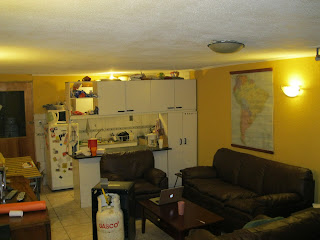It has now been more than three months since I have written anything on this sorry excuse of a blog and I realize that some of you are probably beginning to wonder if I have forgotten about you and the world outside of Chile. It’s harder to keep up with this than I had imagined, but I think it’s worthwhile so I’m going to try to breathe some life back into this thing.
As far as the present is concerned, I have been enjoying a few weeks of summer break. The school year officially ended on Dec. 15, but professors and those involved in the annual school mission trip had to stick around all through December (with the exception of 3 days for Christmas and a few extra before the New Year). So after two weeks of meetings during the end of December with the students participating in the school mission trip, I had about five days off for New Years. Then from January 4-17, me and about 8 other adults plus 50 students went about 4 hours outside of Santiago to go on the annual mission trip that the school does. Since returning, I have been enjoying some free time on my summer break and also helping at an orphanage that the Congregation is in charge of here in Santiago. I just returned from a 10 day trip to the south of Chile and Argentina, and tomorrow I have to go back to school. Time really does fly.
That, very briefly, has been the last 3 months in a nutshell. However, I want to tell you a bit about my sister’s brief visit to South America this past November. My older sister Betsy came to Santiago to visit from Nov. 10-22. Though I was in school at the time, we were able to get away on the weekends that she was here and we had a great time. During her first few days, Betsy went out on her own each day to explore Santiago, which I thought pretty impressive considering the fact that she knew no more than 10 words in Spanish. On Friday the 12th, we had some friends over to our house to have a small party for Christine, one of my housemates, whose birthday was earlier that week.
 |
| View from Valparaíso |
We forced ourselves out of bed early Saturday morning to catch a bus to a small coastal town called Quintero, which is about two hours northeast of Santiago. There we settled in at a surfer’s hostel on a quiet and remote beach. After setting our bags down and enjoying a nice seafood lunch on the beach, the hostel staff let us know that everyone was going on a surf excursion later in the afternoon and invited us along. Betsy and I had never surfed before, but they assured us that if we tried it, we’d love it. We headed about south to Playa Concon (Concon Beach), which is close to Viña del Mar, Chile’s number one coastal destination for vacationers. Within an hour or so, we had learned the basics and were surfing. The water in these parts is especially cold due to the Humboldt Current, which comes up from Antarctica, so even with full-body wetsuits we were pretty cold. After our afternoon surf session, we went back to the hostel where everyone gathered for an excellent barbecue, prepared by an Australian chef who was staying there. On Sunday, we headed down the coast to Valparaíso, Chile’s biggest port city famous for its Bohemian culture, art, and laid-back living. Valparaíso is a really great city to just walk around and get lost in, as it’s full of random art galleries, interesting graffiti and murals, and great places to sit down and enjoy some seafood. So for our afternoon there, we did just that; walked up and down a few of the cities many hills, found lots of random street art, and enjoyed some great seafood and views of the ocean.
 |
| ATVing in the Andes near Mendoza, Argentina |
The following week I was at school while Betsy toured the city, but on Thursday evening, we headed east over the Andes Mountains to visit Mendoza, Argentina. We spent a pretty relaxing weekend there visiting a couple of wineries, ATVing in the foothills of the Andes, and enjoying some of the great food that Argentina has to offer. It was a relaxing weekend, but on the mountain pass on the way back to Chile, our bus broke down and for an hour or so, it looked like we would be stranded there waiting half a day for another bus. However, a mechanic was able to reach us after an hour or so and we were on our way back to Santiago.
 |
| ...while they fixed the bus. |
 |
| Hiking around... |
The following day I went back to work, Betsy packed, and in the evening I accompanied her to the airport and she was off. Her visit was relatively brief, but it was good to see some family and have a reminder of everyone else from back home. Hope all of you are well and for those of you in the Midwest, I hope the worst of winter has passed (it was 90 degrees in Santiago yesterday, just to give you frame of reference for comparison)!
 |
| Chile vs. Uruguay soccer game, Wed. Nov. 17 |










